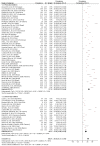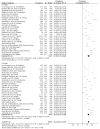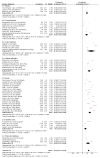Prevalence of Anemia in Children from Latin America and the Caribbean and Effectiveness of Nutritional Interventions: Systematic Review and Meta⁻Analysis
- PMID: 30654514
- PMCID: PMC6356363
- DOI: 10.3390/nu11010183
Prevalence of Anemia in Children from Latin America and the Caribbean and Effectiveness of Nutritional Interventions: Systematic Review and Meta⁻Analysis
Abstract
Anemia affects 1.62 billion people worldwide. Latin America and the Caribbean (LAC) comprise several developing countries where children are a population at risk. This systematic review and meta-analysis aimed to estimate the prevalence of anemia in this population. Electronic databases, reference lists, and websites of health ministries were searched until December 2018. Stratified analyses were performed using RevMan5.3 to estimate the overall prevalence of anemia in preschool and school-age children. The effectiveness of nutritional interventions was also evaluated. We included 61 studies from the 917 reviewed, which included 128,311 preschool- and 38,028 school-age children from 21 LAC countries. The number of anemic children was 32.93% and 17.49%, respectively, demonstrating a significant difference according to age (p < 0.01). No difference was observed by gender and only school-age children from low/very low socioeconomic status (SES) (25.75%) were more prone to anemia than those from middle SES (7.90%). It was not a concern in the Southern Cone but constituted a serious public health problem in the Latin Caribbean. Nutritional interventions reduced the prevalence from 45% to 25% (p < 0.01). Anemia is still a public health problem for children in LAC countries. National surveys should include school-age children. Further nutritional interventions are required to control anemia.
Keywords: Caribbean; Latin America; anemia; developing countries; low- and middle-income countries; meta-analysis; preschool children; school-age children.
Conflict of interest statement
The authors declare no conflict of interest.
Figures









References
-
- De Benoist B., McLean E., Egli I., Cogswell M. Worldwide Prevalence of Anaemia 1993–2005: WHO Global Database on Anaemia. WHO; Geneva, Switzerland: 2008.
-
- World Health Organization . Nutritional Anaemias: Tools for Effective Prevention. WHO; Geneva, Switzerland: 2017.
-
- Pan American Health Organization . Anemia in Latin America and the Caribbean, 2009. PAHO; Washington, DC, USA: 2010.
Publication types
MeSH terms
Substances
LinkOut - more resources
Full Text Sources
Medical

